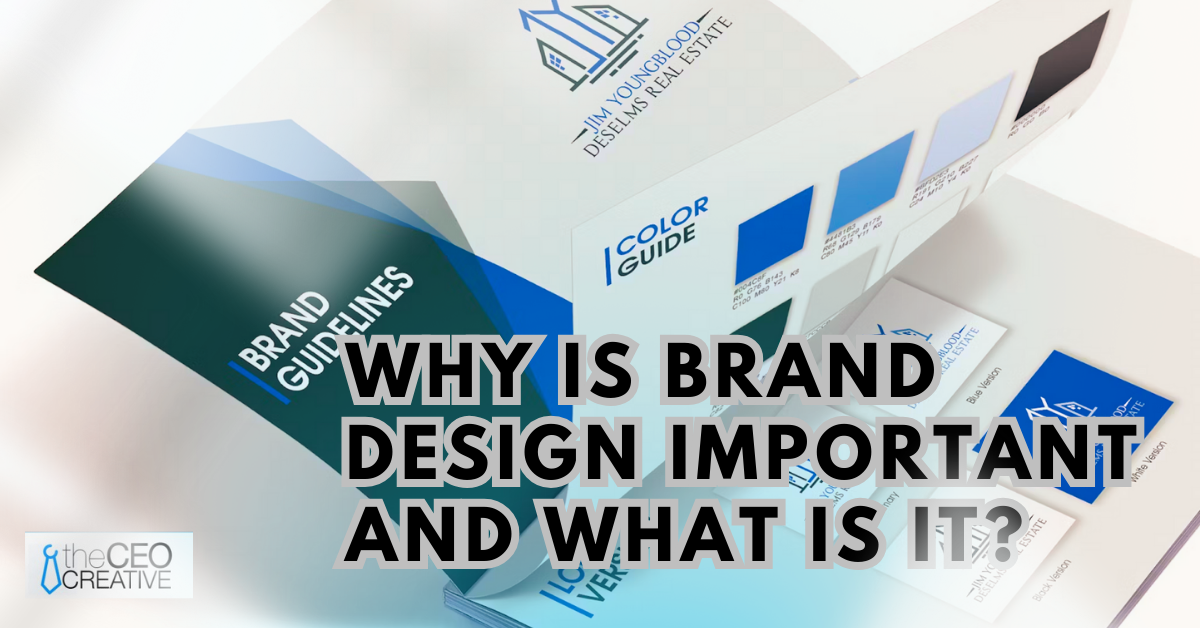What makes a successful business stand out from the crowd? How can something as seemingly small as brand design have a massive impact on your venture’s success? Why do many entrepreneurs underestimate its importance, and what could they be missing out on?
In this blog, we’ll delve into the world of brand design, uncover its significance, and answer these pressing questions. We’ll explore why brand design is not to be taken lightly and why it should be a top priority for every startup. Get ready to discover the hidden power of design in business success.
Definition and Basics of Brand Design
Brand design is more than just an attractive logo or catchy tagline. It’s an intricate blend of several components that include:
- Logo Design
- Typography
- Color Palette
- Imagery
- Layout & Space
- Brand Voice and Messaging
Essentially, it is all about creating a unique and attractive image of your business to communicate your brand’s core values and goals effectively. It helps to shape the perceptions of your customers, setting a solid foundation for customer loyalty and advocacy.
Importance and Role of Brand Design in Business
Brand design plays a key role in establishing a powerful corporate identity. It aids your business in standing out from rivals and creating profound connections with your target audience.
With a top-notch brand design, your business can achieve distinctiveness, and recognition and can attract and retain loyal customers with relative ease. Good design doesn’t just look nice; it solves problems and propels your business upfront. In essence, brand design acts as a linchpin in a company’s quest for growth and success.
What Constitutes a Brand Design?
Brand design is not a singular entity; instead, it’s a perfect blend of various elements that mesh together to create a captivating corporate identity. It is like an art form that captures the essence of your business in the visual and communicative aspects, thus transforming it into a relatable and recognizable entity. Three of the major pillars of brand design are:
Logo Design
Arguably, the heart of the brand design is the logo. An articulate and unique logo is the immediate identifier for your company. It’s the visual hook that catches the eye and leaves a lasting imprint in the viewer’s mind. A well-crafted logo communicates the personality, professionalism, and purpose of your business without needing a word.
Color palette and typography
In addition to the logo, other visual elements such as color palette and typography also create a complete image of your brand. Colors evoke emotions, while typography conveys the brand’s personality. For example, professional companies often prefer neutral colors and simple fonts, while creative industries may prefer bright colors and quirky fonts.
Brand Messaging and Advertising Styles
Last, but certainly not least, is your brand messaging and advertising style. This encompasses the tone and manner in which your brand communicates with its audience. A strong brand message is clear, compelling, and direct, creating an emotional bridge between the business and its customers. The advertising style further specifies how this brand voice is broadcast to the world. Whether traditional or digital, formal or casual, each approach has the power to shape public perception of your brand.
Importance of a Unique Brand Design
In the vast sea of competitive businesses, a unique and appealing brand design can be the lifeline your company needs to stay afloat and stand out.
Helps Differentiate Your Business
Creating a distinctive brand design helps differentiate your business from others. It’s not just about splashing colors on your logo but about conveying what you stand for uniquely and innovatively. This means every element of your design embodies your values and mission. From the shapes and color scheme to the fonts used, every aspect can speak volumes about your business.
- It brings a distinct personality to your business.
- It communicates your brand message effectively.
- It builds credibility and positions you as a leader in your industry.
Strengthens Recall Value Among Customers
A well-thought-out brand design doesn’t just attract the eyes; it’s etched in people’s minds. The consistent use of a distinct design across all platforms enhances brand recognition, creating a lasting impression. This heightened visibility increases recall value, boosting your chances of customers choosing you over competitors.
- It aids in customer recall during the purchase decision.
- It spurs decision-making in favor of your brand, influenced by familiarity.
- It paves the way for brand loyalty.
Importance of Staying True to Your Brand
Finally, once a compelling brand design is established, it’s essential to stay true to it. This means maintaining consistency in your brand design elements across all business touchpoints. This not only reinforces your corporate identity but also nurtures trust with your customers.
- Consistency ensures your brand is recognizable and reliable.
- It affirms your credibility in the marketplace.
- It instills trust and fosters customer loyalty.
The Role of Brand Design in Corporate Identity
Brand design plays a crucial role in molding a business’s corporate identity. From logos and typography to color schemes and imagery, every visual element of your brand design serves as a message to your audience about who you are and what you stand for.
Consistency in Branding Efforts
Consistency is key when it comes to effective brand design. No matter where or how consumers interact with your brand— be it a website, social media, packaging, or advertising—everything should look and feel consistent.
- Uniformity in font, color, and imagery across platforms assures customers they are interacting with the same brand everywhere.
- Consistent messaging and tone reinforce your brand’s personality, creating familiarity and resonance.
Building Trust and Credibility
Trustworthy brand design is what separates successful businesses from also-rans. A well-designed brand that maintains consistency promotes credibility.
- Cultivating trust leads to customer loyalty, which in turn leads to repeat business and referral traffic.
- A professional-looking, well-maintained brand design signals to consumers that you are serious about your product or service.
Reflecting Company Values and Culture
A strong brand design is also an authentic reflection of your company’s values and culture.
- Your brand design can convey messages about your commitment to quality, innovation, customer service, or sustainability.
- t gives you the opportunity to showcase your unique company culture, making a personal connection with your audience.
In essence, your brand design holds the power to tell a rich, nuanced story about who you are as a company, and what sets you apart.
Powerful Brand Design and Business Success
Have you ever wondered how giant companies like Apple or Nike have managed to stay at the top of their industries for decades? Well, they have more than just incredible products to thank for that. They’ve strongly invested in unique brand designs that enhance customer perceptions, improve sales, influence market positions, and spark undying loyalty.
Enhancing Customer Perceptions and Loyalty
A critical aspect of the brand design importance comes into play when considering customer perceptions and loyalty. A well-executed brand design often builds trust and respect among customers, which subsequently results in loyalty. If your brand articulates a cogent, consistent message through its design, it exudes professionalism and reliability. People gravitate towards what makes them feel secure and comfortable. To sum up:
- A strong brand design improves customer recognition.
- It fosters trust and loyalty.
- It ultimately creates enduring customer relationships.
Impact on Sales and Market Position
If you guessed that excellent branding would lead to an increase in sales, you hit the nail right on the head. A great brand design effortlessly communicates your business’s values, creating a unique selling proposition that positions you favorably in the market. Let’s break it down:
- Unique brand designs can enhance the perceived value of your product or service, justifying higher price points.
- It indirectly triggers higher sales figures by appealing to targeted customers.
It helps carve out a niche in a crowded marketplace.
Case Studies Demonstrating the Success of Strong Brand Designs
Companies like McDonald’s, Coca-Cola, and Amazon serve as global examples of how powerful branding can shape a corporate identity and drive monumental business success. All these companies had humble beginnings but with the help of killer branding strategy, they became dominant industry players. Stay tuned as we delve into these case studies further in the upcoming sections of this blog.
Creating a Winning Brand Design for Your Business
Designing a brand that resonates with your target market, aligns with your business strategy, and stands apart from the competition is not a cakewalk, but it’s certainly not impossible. Let’s break down these elements further.
Understanding Your Market and Customers
The first step involves understanding your market and potential customers. Find out what appeals to and incites them. Dive into their demographics, preferences, and behaviors. For instance, a tech-savvy youth audience might appreciate a sleek, modern design, while an older demographic might prefer something more traditional and straightforward. Remember, your brand design should mirror what your customers value and desire.
- Identify what speaks to your customers
- Understand the psychographics & demographics
- Use customer insights to guide the design process
Aligning with Your Business Strategy
Next, your brand design should align seamlessly with your overall business strategy. If your core mission is about sustainability, for example, your brand design might emphasize green colors and earth-oriented imagery.
Reflect your values and missions in your design
Ensure consistent communication of the brand persona
Working with Design Professionals
Lastly, don’t underestimate the power of professional assistance. Capable designers can provide a unique perspective, helping your brand to capture attention and evoke desirable feelings. They know how to marry aesthetics with function, creating a brand design that’s both beautiful and effective.
- Employ professionals for unique and compelling designs
- Leverage their expertise for a functional & aesthetic outcome
By understanding these components, you’re on your way to creating a brand design that will not only align with your business but also draw and retain the right audience.
Conclusion: Brand Design as a Key to Business Success
In finalizing this discussion, let’s take a moment to recall what we’ve been through.
Recap of Brand Design Importance
- The brand design creates visibility and distinguishes your brand from others.
- It helps evoke emotions and build connections with customers.
- It communicates your brand’s story and underlines its core values.
- It contributes to the seamless user experience with consistency in visual elements.
The significance of brand design to a business can’t be underestimated. Its strategic application furnishes identity, fosters trust, and inculcates a superior brand perception.
Final Thoughts on Its Role in Fostering Business Success
Despite the modern business’s many considerations, overlooking brand design could be a scornful mistake. It’s more than a fancy logo or catchy tagline – it’s a comprehensive visual representation of your company’s vision, mission, and values. An effective brand design offers a competitive edge, drives customer loyalty, and ultimately, boosts the business’s bottom line. As we navigate the ever-evolving business landscape, we must embrace brand design as an indispensable component for achieving business success.

















